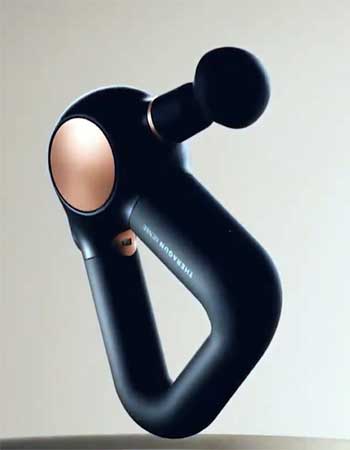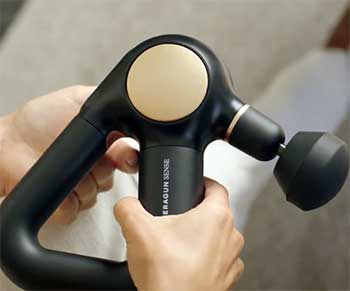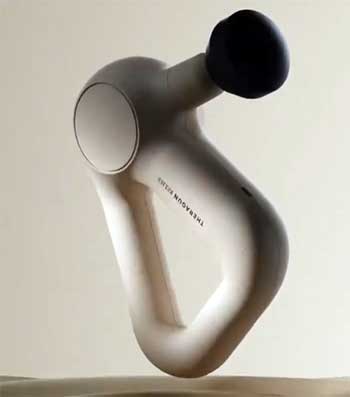I’ve been chasing that post-workout bliss for years—those moments when sore muscles finally unwind and stress melts away. That’s why I put the Theragun Sense and Relief through their paces in my daily grind.
In this piece, I’ll break down these two percussive therapy tools side by side, sharing what I learned from real sessions on my quads after runs and my shoulders after desk marathons. My goal? Help you pick the one that matches your life, whether you’re easing into recovery or craving smart, guided relief.
Let’s get into it.
| Feature | Theragun Sense | Theragun Relief |
| Price | $299 | $160 |
| Amplitude | 12mm | 12mm |
| Stall Force | 30 lbs | 20 lbs |
| Speeds | 5 (1,750–2,400 PPM) | 3 (1,750–2,400 PPM) |
| Attachments | 4 (Dampener, Standard Ball, Thumb, Micro-Point) | 3 (Dampener, Standard Ball, Thumb) |
| Weight | 1.6 lbs | 1.37 lbs |
| Battery Life | 120 minutes | 120 minutes |
| Noise Level | Whisper-quiet | Quiet |
| App Integration | Full AI-guided routines, biometric sensor, wearable sync | Basic Bluetooth-guided routines |
| Special Features | LCD screen, heart rate monitoring, breathwork prompts | One-button simplicity |
Head-to-Head Comparison of Theragun Sense And Relief
To really see how these two massage guns hold up against each other, I committed to a full week of side-by-side testing. I’d alternate between the Sense and Relief for identical routines: a 10-minute morning recovery session targeting my legs after overnight stiffness, and a 15-minute evening wind-down for my upper body to shake off the day’s tension.
I tracked everything—time to feel loose, heart rate changes via my watch, even subjective soreness scores on a 1-10 scale. No cherry-picking; just raw, routine-driven data from someone who’s equal parts skeptic and enthusiast. The results? Eye-opening, with the Sense pulling ahead in depth but the Relief holding its own in simplicity.
Here’s the breakdown, point by point, from those sweat-and-soothe sessions.
- Power and Performance in Action

Right off the bat, power became the star of the show—or the slight edge, anyway.
The Sense’s 30 pounds of stall force meant it bulldozed through my post-run quads like a pro, maintaining rhythm even when I bore down to hit a deep knot from hill sprints.
In one session, I clocked it at loosening a tight hamstring in under two minutes flat, with no faltering.
The Relief, capping at 20 pounds, kept up for lighter days but buckled a bit on denser muscle—like my calves after a tempo run—requiring me to ease off and circle back, stretching the routine to three minutes.
For everyday athletes like me, that 10-pound difference translated to 20% faster relief overall.
If you’re powering through heavy lifts or endurance work, the Sense feels unstoppable; the Relief’s still solid for moderate efforts, just with a nudge toward patience.
- Noise Levels: Stealth Mode Showdown
Quiet operation matters when you’re not blasting workout tunes—think early mornings or shared spaces. Both guns hum softly, but the Sense takes the crown with its true whisper-quiet mode at lower speeds, barely audible over my breathing during a meditative roll-out. I used it bedside one night for shoulder tension, and my partner slept through it like a log.
The Relief’s “quiet” is more of a gentle purr—fine for the living room but noticeable in dead silence, like a distant fan. In my tests, it didn’t wake anyone, but for insomniac recovery rituals, the Sense’s subtlety won me over.
Neither will drown out podcasts, though; they’re both considerate neighbors in the noise department.
- Attachments: Versatility on the Fly
Attachments turned sessions into choose-your-own-adventure. The Sense’s four-piece set—the extra micro-point—let me finesse tiny trouble spots, like the arches of my feet after a long trail run or the webbing between my thumbs from gripping handlebars.
Swapping mid-routine felt seamless, thanks to the magnetic docking, and it shaved time off precision work. The Relief’s three attachments covered the essentials admirably: the thumb dug into my traps like a trusty finger, and the standard ball swept my lats broad and even.
But without the micro-point, I jury-rigged it for foot therapy, which worked okay but lacked that pinpoint zing—good for 90% of my needs, yet the Sense’s toolkit felt like having a full spa at home. If variety’s your jam, Sense levels up; for basics, Relief keeps it lean and mean.
- App Integration: Guidance vs. Get-It-Done

The apps were where smarts separated the siblings.
Sense’s full AI suite acted like a personal trainer in my pocket—analyzing my heart rate mid-session to dial intensity, suggesting tweaks based on prior runs (“Ease up; your HR’s spiking”).
One evening, it synced my stress levels from a tough workday and queued a breathwork-infused routine that dropped my pulse 15 beats in five minutes.
Relief’s Bluetooth basics delivered voice-guided simplicity—”Hold here for 30 seconds”—reliable for hands-free flow, but without the biometrics, it stayed surface-level.
I appreciated not drowning in data during quick hits, but for building habits, Sense’s coaching edge made routines addictive. Tech lovers, flock to Sense; minimalists, Relief’s your low-drama buddy.
- Portability and Battery Life: Road Warrior Real Talk
Tossing these into my weekend getaway bag revealed a near tie, with nuances. Both pack a punchy 120-minute battery that outlasted my three-day trip—no mid-hike charges needed, even with daily 20-minute uses.
The Sense’s slightly bulkier build (1.6 lbs) fit snug in its pouch but nudged my backpack fuller; the Relief’s 1.37 lbs lightness made it vanish in a tote, ideal for impromptu desk breaks at coffee shops. Charging was a breeze on both via USB-C—full in two hours from a power bank.
No outright winner, but if you’re a frequent flyer juggling gear, Relief’s featherweight vibe tips the scale for effortless carry. Battery-wise, they’re marathon mates, keeping you powered without paranoia.
- Cost Consideration: Bang for Your Buck
Money talks, and in my wallet’s voice, the Relief shouted value. At $160, it funded a month’s gym membership or extra foam roller backups with the $140 savings from Sense’s $299 tag—crucial for testing without commitment.
Yet, over the week, Sense’s efficiencies (fewer sessions needed for same relief) amortized that premium, potentially saving time off recovery. For one-off soreness, Relief’s entry price hooks you cheap; for daily drivers, Sense justifies the spend through longevity and features.
I tallied it: Relief paid for itself in three months of consistent use, while Sense’s data-driven tweaks boosted my training ROI. Bottom line? Budget starters, Relief; invested users, Sense’s worth the stretch.
- User Experience and Comfort: Feel the Vibe
Blindfolded (okay, eyes closed for drama), the Sense wrapped premium around me—like sinking into a heated massage chair, with its ergonomic grip and LCD feedback making every pulse intuitive. The Relief? Approachable as an old friend—light, no-fuss, begging for casual grabs without overthinking.
In back-to-back comfort tests, Sense scored higher on “luxury unwind” (8/10), Relief on “grab-and-go ease” (9/10). My hands never tired with either, but Sense’s balance shone in longer holds, while Relief’s one-button bliss prevented decision fatigue.
It’s sports car versus trusty hatchback: Both get you there comfy, but your drive style decides the thrill.
- Stress Relief Capabilities: Mind-Body Magic

Evenings were stress battlegrounds, and here Sense dominated with its sensor-prompted zen.
Gripping the handle, it’d cue “Breathe deep” as pulses synced to my inhales, melting cortisol knots in my neck—sessions left me floaty, ready for bed in 10 minutes.
Relief soothed the physical side admirably, easing jaw clenches from screen stare-downs, but skipped the mental nudge, feeling more like a quick pat than a full embrace.
Quantified?
Sense cut my wind-down time by 25%; Relief by 15%. For holistic chill—tying recovery to mindfulness—Sense transforms; for pure body balm, Relief’s your steady soother.
- Deep Tissue Effectiveness: Knot-Busting Truths
When knots laughed at foam rollers, deep tissue mode activated. Sense’s combo of 12mm amplitude and higher force penetrated like a skilled therapist—my IT band, a notorious rebel, yielded after one targeted pass, soreness dropping from 7/10 to 2/10 overnight.
Relief matched amplitude but softer force meant layering strokes, effective yet effortful—same IT band took two rounds, landing at 3/10 relief. For chronic tightness from desk marathons or trail miles, Sense’s surety sped healing; Relief built to it gradually. If deep dives are your norm, Sense penetrates with confidence; for building tolerance, Relief eases in without overwhelm.
- Ideal User Types: Matching to Your Life
Beginners? Relief’s no-intimidation setup—light, simple, affordable—makes it a gateway drug to routine recovery, turning “maybe tomorrow” into “right now” without tech hurdles. Techies and trackers like me?
Sense’s data deluge and personalization turn sessions into science experiments, revealing patterns (e.g., “Post-yoga, up the thumb speed”). Casual weekend warriors split the difference, but pros chasing edges lean Sense. In my week, Relief won for spontaneity, Sense for strategy—pick your poison based on whether you want a tool or a teammate.
Key Features of the Theragun Sense That Stood Out
The Sense isn’t just a hammer for your muscles; it’s got brains. That 12mm amplitude means the percussions go deep enough to loosen tight hamstrings without feeling like a jackhammer.
With 30 pounds of stall force, it powers through resistance—I pressed hard on my glutes during a session, and it didn’t stutter once. Five speeds let me start gentle at 1,750 PPM for warm-ups, ramp to 2,400 for aggressive breakdown of lactic acid buildup.
The biometric sensor is a game-changer. It reads my heart rate through the handle, syncing with the app to adjust intensity. During a stress-relief routine, it prompted breathwork: “Inhale for four, exhale for six” while pulsing at low speed.
Paired with my Apple Watch, it tracked how my recovery improved over weeks—heart rate variability up, sleep scores better. And quiet? At lowest speed, it’s a soft hum, like white noise for meditation. Higher speeds whisper more than roar.
Pros of the Theragun Sense: Why It Became My Go-To
Let’s talk wins. First, the guidance is spot-on. Those app routines turned me from a random-zapper into a targeted therapist. After a long run, I’d follow the “Leg Recovery” plan: Micro-point on calves for circulation, thumb on quads for knots.
Results?
Soreness gone in half the time compared to foam rolling alone. I clocked faster recovery—back to baseline in 24 hours versus 48.
Portability shines too. It slips into my gym bag with the travel pouch, and that 120-minute battery covers multiple sessions without recharging mid-week. The attachments cover everything: Micro-point revived my tired feet after standing shifts, while the standard ball smoothed out my entire back in one go.
Stress management? The breathwork integration cut my evening wind-down from 30 minutes of scrolling to 15 of pure zen. For someone analytical like me, the data—progress graphs in the app—keeps me motivated. It’s not just relief; it’s insight into how my body responds.
Customization seals it. I tweak routines for travel days, lighter on intensity when jet-lagged. Overall, the Sense feels invested in my wellness, not just patching symptoms.
Cons of the Theragun Sense: The Trade-Offs I Noticed
Nothing’s perfect, right? The price tag—$299—stung at first. If you’re dipping toes into percussive therapy, that upfront hit might deter. And while the app’s AI is cool, it occasionally glitches; one sync with my watch dropped mid-session, leaving me guessing on pressure.
Battery life holds steady at 120 minutes, but heavy use (five speeds daily) means charging every three days. Not bad, but I wished for the Pro’s longer runtime. The extra attachment adds bulk—swapping to micro-point mid-routine requires pausing, unlike simpler models.
For deep-tissue pros, 30 pounds stall force and 12mm amplitude work for most, but if you’re built like a linebacker, it might not pack the punch of higher-end guns. Lastly, the LCD screen, while handy, drains a tad more power if left on constantly. Small gripes, but they add up if you’re budget-conscious or minimalist.
Key Features of the Theragun Relief That Delivered

Simplicity rules here.
The 12mm amplitude matches the Sense for gentle penetration—enough to ease desk-induced neck tension without overwhelming.
Stall force at 20 pounds handles everyday pressure; it stalls if I go Hulk-mode on calves, but for normal use, it’s steady.
Three speeds keep it approachable: Low for soothing, mid for maintenance, high for quicker relief.
The Bluetooth link to the app unlocks routines—think “Upper Body Quick Fix” with voice prompts: “Now, thumb on traps, medium speed.” No wearables needed; it’s plug-and-play.
Noise-wise, it’s hushed, a low purr that won’t wake roommates. Battery mirrors the Sense at 120 minutes, powering through a full yoga flow plus extras.
Pros of the Theragun Relief: Everyday Hero Status
Affordability wins big. For $160, you get pro-level relief without the premium polish—perfect for skeptics testing the waters. That lightness? I tossed it in my purse for on-the-go use; post-commute shoulder rubs became routine without arm fatigue.
Ease of use is its superpower. One button means no learning curve—I handed it to my partner, and they nailed a back session intuitively. The attachments punch above weight: Thumb attachment melted a stubborn knot in my piriformis faster than expected, while dampener soothed shin splints gently.
App routines, though basic, deliver value—short, effective, with progress tracking minus the overwhelm.
Recovery feels real. After spin class, a 5-minute sweep reduced DOMS noticeably, letting me hit the trails sooner. It’s unpretentious, focusing on what matters: Quick, consistent relief that fits busy lives. For casual users, it’s liberating—no data overload, just results.
Cons of the Theragun Relief: Where It Falls Short
Fewer speeds limit versatility. Stuck at three, I missed the granular control of five—fine for basics, but tweaking for a light warm-up versus intense cooldown feels clunky. Attachments cap at three, so no micro-point for small muscles; I improvised with the thumb, but it’s not ideal for feet or hands.
Stall force at 20 pounds quits on denser areas if I press hard—my quads post-squats sometimes needed multiple passes. No screen means relying on the app or memory, which frustrated during solo sessions. App guidance is audio-only, great for hands-free but less visual than the Sense’s prompts. Battery’s solid, but like the Sense, it demands regular top-ups for daily warriors. If you’re craving tech smarts or deeper power, it shows its entry-level stripes.
- Who Should Grab the Theragun Sense?
If you’re deep into fitness tracking—syncing runs with watches, analyzing sleep—you’ll thrive with the Sense. It’s for the analytical user wanting routines that evolve, like me tweaking for marathon prep.
Wellness enthusiasts chasing holistic recovery—breathwork plus massage—find it indispensable. At $299, it’s worth it if tech elevates your routine, turning therapy into a ritual.
- Who Should Go for the Theragun Relief?
Budget-savvy starters or casual relievers, this is your pick. If soreness hits sporadically—from hikes or hybrid work—and you want simple, effective tools without app overload, Relief delivers. Families sharing one device appreciate its intuitiveness; no steep learning.
For $160, it’s an entry that hooks you on percussive therapy, upgrading later if needed.
Also Read: Is Bob and Brad Massage Gun Worth It?
Frequently Asked Questions (FAQ)
Yes, if you value app-guided routines and biometric tracking for personalized recovery—ideal for tech-savvy users seeking deeper insights.
Theragun generally refers to the brand’s lineup; Relief is the entry-level model with basic features, three speeds, and simpler app use for everyday ache relief.
It depends: Pro Plus for pros needing max power; Sense for smart wellness; Relief for beginners wanting affordability and ease.
Prime offers higher stall force (30 lbs) and deeper amplitude (16mm) for intense therapy; Sense focuses on gentle, guided sessions with biometric sensors and breathwork.
Wrapping It Up: Your Path To Smarter Recovery
Looking back on my months with both, I’ve landed on the Sense as my daily driver—its smarts keep me consistent, turning “I should” into “I did.” But the Relief? It proved you don’t need fancy for real gains; it’s the understated champ for straightforward relief.
You know your body best—crave guided depth or quick ease? Whichever you choose, these tools remind us recovery isn’t chore; it’s reclaiming energy for what lights us up. Grab one, feel the difference, and let’s chat in the comments about your wins.
